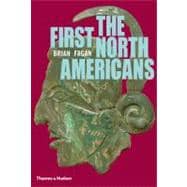
Note: Supplemental materials are not guaranteed with Rental or Used book purchases.
Purchase Benefits
What is included with this book?
| Preface | p. 7 |
| Chronological Table | p. 10 |
| Foundations | |
| The Earliest Americans | p. 13 |
| Chronological table | p. 12 |
| Ultimate origins: genetics, teeth, and languages | p. 14 |
| The pre-Clovis question | p. 18 |
| Beringia and a tale of microblades | p. 21 |
| Moving south | p. 26 |
| The world of Clovis | p. 26 |
| Mass extinctions | p. 30 |
| After Clovis | p. 33 |
| Hell Gap | p. 33 |
| Bison hunting on the Plains | p. 35 |
| The western interior | p. 37 |
| The Eastern Woodlands | p. 43 |
| Restricted mobility | p. 47 |
| The issue of sedentism | p. 48 |
| Burials and the lands of the ancestors | p. 52 |
| The Far North: West to East | p. 55 |
| Chronological table | p. 54 |
| The Paleoarctic tradition | p. 55 |
| Coastal adaptations: Ocean Bay and Kachemak | p. 57 |
| The Aleutian tradition | p. 59 |
| The Arctic Small Tool tradition | p. 62 |
| First settlement of the eastern Arctic | p. 64 |
| Foraging the West Coast | p. 71 |
| Chronological table | p. 70 |
| A diverse coastal world | p. 71 |
| Early settlement of the Northwest Coast | p. 73 |
| The Northwest: salmon, food surpluses, and exchange | p. 74 |
| South of the Klamath River | p. 78 |
| Before the Pueblos | p. 93 |
| Archaic societies | p. 93 |
| Maize comes to the Southwest | p. 95 |
| The beginnings of village life | p. 102 |
| Fremont farmers in the Great Basin | p. 107 |
| People of the Plains | p. 111 |
| Chronological table | p. 110 |
| The Plains Archaic | p. 113 |
| Bison jumps | p. 114 |
| Protohistoric times | p. 117 |
| Village farmers on the Plains | p. 119 |
| The Eastern Woodlands: Nuts, Native Plants, and Earthworks | p. 127 |
| A container revolution | p. 127 |
| Cultivating native plants | p. 128 |
| Late Archaic societies | p. 130 |
| Exchange and interaction | p. 134 |
| Cemeteries and burial mounds | p. 137 |
| Poverty Point | p. 138 |
| Apogee | |
| The Far North: Norton, Dorset, and Thule | p. 142 |
| The Norton tradition | p. 142 |
| The Thule tradition in the west | p. 143 |
| The Dorset tradition of the eastern Arctic | p. 147 |
| Thule expansion in the eastern Arctic | p. 152 |
| Classic Thule | p. 155 |
| Post-Classic Thule | p. 157 |
| The West Coast: Not a Garden of Eden | p. 158 |
| The Late Period Northwest Coast | p. 158 |
| Links to historic peoples | p. 159 |
| The interior plateau | p. 162 |
| The California coast | p. 165 |
| The Medieval Warm Period | p. 166 |
| Northern and central California | p. 167 |
| Southern California coast | p. 169 |
| The Southwest: Villages and Pueblos | p. 175 |
| Chaco Canyon | p. 176 |
| Hohokam: the desert irrigators | p. 181 |
| Mesa Verde | p. 193 |
| Katcinas and warriors | p. 198 |
| Paquime (Casas Grandes) | p. 200 |
| The Eastern Woodlands: Moundbuilders | p. 203 |
| Chronological table | p. 202 |
| Burial mounds and the Adena complex | p. 203 |
| Hopewell | p. 208 |
| Earthworks and cosmos | p. 212 |
| The Hopewell decline and effigy mounds | p. 218 |
| The Mississippian: Eastern Woodlands Climax | p. 220 |
| A triad of cults | p. 221 |
| Subsistence and exchange | p. 223 |
| Cahokia: a great chiefdom | p. 225 |
| Moundville | p. 228 |
| What were these complex chiefdoms? | p. 231 |
| Fertility and duality | p. 231 |
| European contact | p. 233 |
| The Northeast: Algonquians and Iroquoians | p. 234 |
| Algonquian and Iroquoian | p. 234 |
| Terminal Archaic | p. 235 |
| Woodland societies | p. 236 |
| Northern Iroquoian origins: Early Iroquoian | p. 237 |
| Middle Iroquoian | p. 240 |
| To European contact and beyond | p. 245 |
| Epilogue | p. 250 |
| The holocaust of disease | p. 250 |
| Furs and wampum | p. 251 |
| The Spanish borderlands | p. 253 |
| Further Reading | p. 258 |
| Sources of Illustrations | p. 263 |
| Index | p. 265 |
| Table of Contents provided by Ingram. All Rights Reserved. |
The New copy of this book will include any supplemental materials advertised. Please check the title of the book to determine if it should include any access cards, study guides, lab manuals, CDs, etc.
The Used, Rental and eBook copies of this book are not guaranteed to include any supplemental materials. Typically, only the book itself is included. This is true even if the title states it includes any access cards, study guides, lab manuals, CDs, etc.